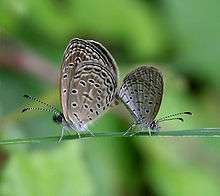Zizula hylax
| Tiny grass blue | |
|---|---|
| | |
| In Kerala, India | |
| Scientific classification | |
| Kingdom: | Animalia |
| Phylum: | Arthropoda |
| Class: | Insecta |
| Order: | Lepidoptera |
| Family: | Lycaenidae |
| Genus: | Zizula |
| Species: | Z. hylax |
| Binomial name | |
| Zizula hylax (Fabricius, 1775) | |
| Synonyms | |
| |

Zizula hylax, the Gaika blue[1] or tiny grass blue is a species of blue (Lycaenidae) butterfly.
Description

Male upperside: dull violet blue, which changes to a brighter tint of violet in certain lights. Forewing: the costa very narrowly, the termen much more broadly dull brown; this edging to the termen in most specimens decreases in width from apex to tornus, and is outwardly followed by an anticiliary darker brown line. Cilia brownish anteriorly, posteriorly brownish at the base with the apical portions white. Hindwing: the ground colour brighter than on the forewing, the costal and terminal margins much more narrowly edged with brown, which edging is merged in the anticiliary dark brown line. Cilia: brown along their basal halves, white apically.
Underside: grey. Forewing: a dusky brown lunular line on the discocellulars; two subcostal spots above the cell, one on either side of the discocellular lunule; a very strongly curved discal series of five spots, of which the posterior three are somewhat lunular in shape and placed obliquely en echelon, the next above these hook shaped, the anterior spot round; both the subcostal spots and the spots of the discal series are black, each narrowly encircled with white; beyond these are inner and outer subterminal dusky lines, which anteriorly are continuous, posteriorly somewhat broken and macular, followed by a very conspicuous jet-black anticiliary slender line. Cilia greyish white, traversed by a medial transverse blackish-brown line. Hindwing: with the following small white-encircled black spots: a subbasal transverse series of three, followed by a highly curved series of eight spots, that curve across the disc of the wing to the costa and along the latter towards the base; discocellulars with a dusky short lunular line as on the forewing; terminal markings and cilia similar, but the outer and broader subterminal line more broken and macular than on the forewing. Antennae black, the shafts ringed with white; head, thorax and abdomen dark brown, with a little violet pubescence on the head and thorax; beneath: palpi, thorax and abdomen greyish white.

Female upperside: glossy brown, without any violet tint whatever; the anticiliary darker brown lines on both forewings and hindwings well marked. Underside: very similar to that of the male, the ground colour a shade darker, the markings slightly larger and more prominent. Antenna, head, thorax and abdomen as in the male, but the latter three without a trace of violet or blue on the upperside.[2]
Distribution
The tiny grass blue is found in several races throughout tropical and subtropical Africa, Asia, and Oceania, including India, Japan, the Philippines, Singapore, Swaziland, north and east coasts of Australia and also in southern Australia.
Life history
The wingspan of the adults is about 1.5 centimetres (0.59 in). The eggs are pale green, round, and flattened, with a diameter of about 0.5 millimetres (0.020 in). They are laid singly on buds and flowers of a food plant. The caterpillars are 0.7 centimetres (0.28 in) long, green with a dark red line along the back, and light and dark lines partway along the sides. The sides are hairy, and the head is pale brown. The pupa is 0.7 cm long, hairy and green, and is attached to a stem or the underside of a leaf of a food plant.

Food plants
Food plants include various members of the family Acanthaceae. Species noted include Hygrophila auriculata and Phaulopsis dorsiflora.[3]
See also
References
- ↑ Woodhall, Steve. Field Guide to Butterflies of South Africa, Cape Town:Struik Publishers, 2005.
- ↑ Bingham, C.T. (1907). The Fauna of British India, Including Ceylon and Burma. II (1st ed.). London: Taylor and Francis, Ltd.
- ↑ Kunte, K. 2006. Additions to the known larval host plants of Indian butterflies. Journal of the Bombay Natural History Society 103(1):119–121
General reading
- Cowan, C.F., 1965. Comment on the proposed designation of a type species for Pithecops Horsfield, 1828. Z.N (S.) 1675. Bulletin of Zoological Nomenclature 22(4):209-210.
- Evans, W.H. (1932). The Identification of Indian Butterflies (2nd ed.). Mumbai, India: Bombay Natural History Society.
- Gaonkar, Harish (1996). Butterflies of the Western Ghats, India (including Sri Lanka) - A Biodiversity Assessment of a Threatened Mountain System. Bangalore, India: Centre for Ecological Sciences.
- Gay, Thomas; Kehimkar, Isaac David; Punetha, Jagdish Chandra (1992). Common Butterflies of India. Nature Guides. Bombay, India: World Wide Fund for Nature-India by Oxford University Press. ISBN 978-0195631647.
- Haribal, Meena (1992). The Butterflies of Sikkim Himalaya and Their Natural History. Gangtok, Sikkim, India: Sikkim Nature Conservation Foundation.
- ICZN. Opinion 822, 1967. Pithecops Horsfield, [1828] designation of a type species under the plenary powers. Bulletin of Zoological Nomenclature 24(4):216-217.
- Kunte, Krushnamegh (2000). Butterflies of Peninsular India. India, A Lifescape. Hyderabad, India: Universities Press. ISBN 978-8173713545.
- Wynter-Blyth, Mark Alexander (1957). Butterflies of the Indian Region. Bombay, India: Bombay Natural History Society. ISBN 978-8170192329.
External links
| Wikispecies has information related to: Zizula hylax |
- Asahi Correctly determined photos of Zizula hylax (synonym)from the Philippines.
| Wikimedia Commons has media related to Zizula gaika. |